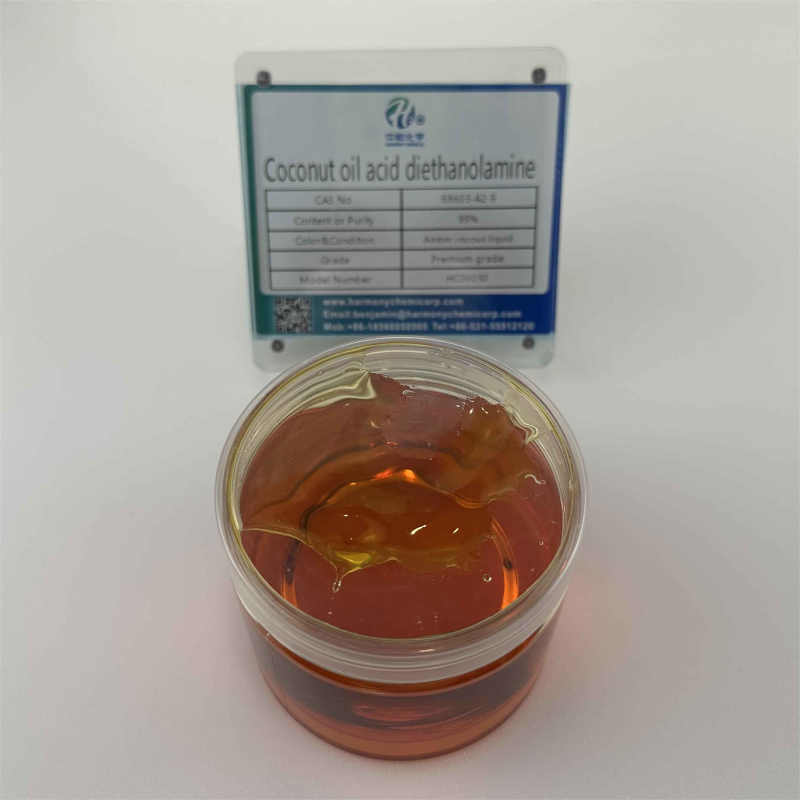Boiling Point168-274 ° COdorat 100.00?%. mild ammoniaSOLUBLE5-10 g/100 mL at 18 ºCStabilityStable. Combustible. Incompatible with strong oxidizing agents.Introduction: N, N-bis (hydroxyethyl) coconut oil amide can be used as a surfactant.
Contact Now
N-methylpyrrolidone is referred to as NMP, molecular formula: C5H9NO, English: 1-Methyl-2-pyrrolidinone, the look is colorless to mild yellow obvious liquid, barely with the odor of ammonia, miscible with water in any proportion, soluble in ether, acetone and ester, haloalkane, fragrant hydrocarbon and different natural solvents, nearly totally combined with all solvents, boiling factor 204 ℃, flash factor ninety one ℃, sturdy hygroscopicity, steady chemic
Contact Now
Usage 1: Used as uncooked substances for photosensitive nylon and photosensitive plastics, constructing grouting materials, and additionally for photography, printing, plate making, etc.Usage 2: It can be used as a water blocking off agent in oilfield drilling operations and development grouting operations, as properly as as as a crosslinking agent in the synthesis of acrylic resin and adhesives.Usage 3: Used as an essential cloth for isolating amino acids and as an vital uncooked fabric&nb
Contact Now
Non toxic, protected and environmentally friendly, non-toxic and odorless, non polluting plants, soil and groundwater, fruit timber and flowers, afforestation, soilless cultivation, plant renovation and transportation, area crops, etc.The ultimate decomposition merchandise of soil water maintaining marketers and water resistant soil loss marketers are carbon dioxide, water, ammonia nitrogen, and sodium or potassium ions, besides any residue.Preserving moisture and saving water can effi
Contact Now
Melting point>300 ° CDensity1.203-1.209 g/cm3FormPowderColorWhitewater solubilitySoluble in water.Merck147668Potassium silicate is a colorless or barely yellow translucent to transparent glassy substance. It has hygroscopicity. There is a robust alkaline reaction. Dissolve in acid to precipitate silica. Slowly soluble in bloodless water or nearly insoluble in water (depending on its composition), insoluble in ethanol.
Contact Now
namePramoxine hydrochlorideCAS NO637-58-1Molecular formulaC17H28ClNO3molecular weight329.86melting point181-183°Storage conditionsInert atmosphere,Room TemperaturesolubilityChloroform (Slightly), Methanol (Slightly)formneatcolourWhite to Off-White
Contact Now
nameAdmireCAS NO105827-78-9Molecular formulaC9H10ClN5O2molecular weight255.66melting point136-144°Cdensity1.542formWhite crystallineVapor pressure2×10-7Pa (20℃)
Contact Now
Polyvinylpyrrolidone, additionally recognised as PVP, is a polymer of ethylene pyrrolidone. Due to its one-of-a-kind ranges of polymerization, it can be divided into soluble PVP and insoluble PVPP (polyvinylpyrrolidone). The relative molecular weight of soluble PVP is 8000~10000, which can be used as a precipitant to precipitate with the aid of reacting with polyphenols. By the use of this method, there are without problems residual PVP in the wine.
Contact Now
Main purposeEthylene glycol dimethyl acrylate is frequently used in the plastic and rubber industries as a crosslinking agent for ethylene acrylic copolymers, ABS, acrylic sheets, pipes, glass fiber bolstered polyester, PVC, ion trade resins, smokeless powder encapsulation polymerization, glazing, etc. is additionally used as a polymer in copolymerization, which will increase hardness, warmness resistance, climate resistance, solvent resistance, and friction resistance.
Contact Now
Manganese carbonate, additionally acknowledged as manganese carbonate, has the chemical components MnCo3. Molecular weight 114.95. White hexagonal crystal or rose purple crystal. Specific gravity 3.125. Difficult to dissolve in water, soluble in dilute acids. Decompose in boiling water. At a hundred ℃, it decomposes into carbon dioxide and manganese oxide, and above 330 ℃, it decomposes to launch carbon dioxide and carbon monoxide. Roasting in air produces manganese trioxide. Roasting in oxygen generates manganese trioxide.
Contact Now
Melting point>300 ° C (lit.)Density1.25Vapor pressure0Paat25 ℃Storage conditionsStorebelow+30 ° CSolubility450g/lFormCrystallinePowderChemicalbookAcidity coefficient (pKa)12.5 [at 20 ℃]ColorWhite to most whitePH value11.7 (110g/l, H2O, 20 ℃)Water solubility450g/L (20 º C)Guanidine carbonate is a chemical substance with the molecular system C2H10N6H2CO3.
Contact Now
nameTopiroxostatCAS NO577778-58-6Molecular formulaC13H8N6molecular weight248.24boiling point594.7±60.0 °C(Predicted)density1.45±0.1 g/cm3(Predicted)Storage conditionsStore at -20°CsolubilityDMSO : 23.5 mg/mL (94.67 mM; Need ultrasonic and warming)Acidity coefficient (pKa)7.47±0.10(Predicted)formPowder
Contact Now
nameCupferronCAS NO135-20-6Molecular formulaC6H9N3O2molecular weight155.15melting point150-155 °C (dec.)boiling point278.95°C (rough estimate)density1.3092 (rough estimate)Storage conditions2-8°CformPowdercolourNeedles from water
Contact Now
nameMK-4827 (tosylate)CAS NO1038915-73-9Molecular formulaC26H28N4O4Smolecular weightmolecular weightmelting point>142oC (dec.)Storage conditions-20°C FreezersolubilityMethanol (Slightly)formformcolourOff-White to Pale Yellow
Contact Now
Tetracaine hydrochloride is used for mucosal floor anesthesia, conduction anesthesia, epidural anesthesia, and subarachnoid anesthesia; Used for ophthalmic floor anesthesia, barring constricting blood vessels, detrimental corneal epithelium, and growing intraocular pressure.nameTetracaine hydrochlorideCAS NO136-47-0Molecular formulaC15H25ClN2O2melting point149°Cdensity1.1279 (rough estimateStorage conditions2-8°Csolubilityalcohol: solublesoluble 40 parts of solventformneatcolourWhite to Almost whiteSOLUBLESoluble in water at 50mg/ml
Contact Now
nameLOXO-292CAS NO2152628-33-4Molecular formulaC29H31N7O3molecular weight525.6density1.36±0.1 g/cm3(Predicted)Storage conditionsStore at -20°CformA crystalline solidAcidity coefficient (pKa)14.00±0.29(Predicted)
Contact Now
nameUrapidil hydrochlorideCAS NO64887-14-5Molecular formulaC20H30ClN5O3molecular weight423.94melting point156-1580CStorage conditionsKeep in dark place,Inert atmosphere,Room temperaturesolubilityH2O: solubleformsolidcolourwhiteSOLUBLESoluble to 50 mM in water
Contact Now
nameLinocaine hydrochlorideCAS NO6108-05-0Molecular formulaC14H25ClN2O2molecular weight288.82melting point75-79℃Storage conditions2-8°CsolubilityH2O: solubleformsolidcolourwhiteSOLUBLESoluble in water (50 mg/ml), chloroform, ethanol, and benzene. Insoluble in diethyl ether.
Contact Now
nameEsmolol hydrochlorideCAS NO81161-17-3Molecular formulaC16H26ClNO4molecular weight331.83melting point48-50°Cdensity1.026Storage conditions−20°CsolubilityH2O: soluble12mg/mLformbuffered aqueous solutioncolourWhite to Off-White
Contact Now
nameAdemetionine disulfate tosylateCAS NO97540-22-2Molecular formulaC22H34N6O16S4molecular weight766.78melting point>122°C (dec.)Storage conditionsInert atmosphere,Store in freezer, under -20°CsolubilityDMSO (Slightly, Heated), Water (Sparingly)formSolidcolourWhite to Pale Yellow
Contact Now
English nameAmmonium Zirconium HexafluorideCAS16919-31-6Molecular formula(NH4)2.ZrF6Molecular weight241.29Density1.15g/mLat 25°C(lit.)Water-solubility287.7g/L at 20℃Storage conditionsRoom TempratureAppearanceWhite crystalsmolecular structure:
Contact Now
Prilocaine is an amide type close by anesthetic. Its anesthetic depth and pace are similar to Lidocaine, alternatively its size is prolonged and its vasodilation have an impact on is weak. The toxicity is limit than lidocaine. Clinically used for close by anesthesia, specially fantastic for victims who hold away from the utilization of adrenaline.namePrilocaineCAS NO721-50-6Molecular formulaC13H20N2Omelting point37-38°boiling pointbp0.1 159-162°density1.0117 (rough estimate)refractivitynD20 1.5298Storage conditions2-8°CformCrystalline powderSOLUBLE6.169g/L(25 ºC)
Contact Now
nameMebendazoleCAS NO31431-39-7Molecular formulaC16H13N3O3molecular weight295.29melting point288.5°Cboiling point436.98°Cdensity1.1952Storage conditionsSealed in dry,2-8°CformneatcolourWhite to Pale Beige
Contact Now
nameClorsulonCAS NO60200-06-8Molecular formulaC8H8Cl3N3O4S2molecular weight380.66melting point194-203°Cboiling point651.7±65.0 °C(Predicted)density1.800±0.06 g/cm3(Predicted)Storage conditionsKeep in dark place,Inert atmosphere,2-8°CformneatcolourWhite
Contact Now





























